Mindlock: The Apartment review
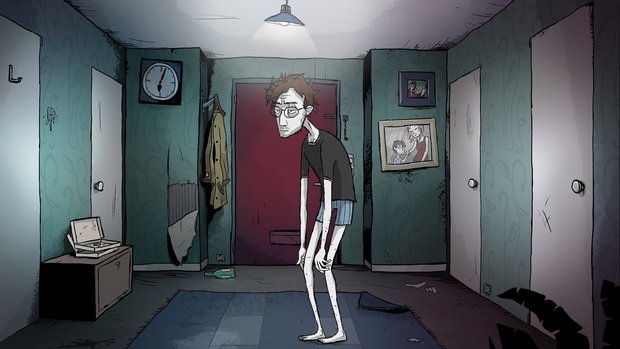
- 7 Comments
Variety and creativity are key in this darkly funny psychological point-and-click adventure
In the course of our lives, we walk different roads depending on the choices we make. Only after time has passed and we look back at the big picture do we see how everything led to the current moment. You might then realize that the choices you made were forced upon you, that your life isn’t really your own, and that you yearn for change and personal individuality.
Colin Walker finds himself in such a situation in Mindlock: The Apartment. He’s stuck in a job he hates because his father arranged it for him, until a strange event sparks the opportunity to completely alter his future. In traditional point-and-click adventure game style, you will inventory-puzzle your way through an obstacle-filled nightmare designed to balance Colin’s self-doubt and self-confidence, deal with the ghosts from his past, and take full control of his life for a change. The game not only astounds with its creativity of gameplay, but also with a humor-filled yet emotionally deep story about standing up for yourself and following your dreams.
The main character is a 22-year-old yuppie type consumed by ennui until his life is turned upside down. (Think Joseph Gordon-Levitt at his most depressive in (500) Days of Summer.) Colin has been working at the customer service department of Toaster & Toaster Inc. under the supervision of one Mr. Price, a golf buddy of his father. Colin hates his job, and by extension his entire life, and it shows in the way he behaves and takes care of himself – or rather, DOESN’T take care of himself. The moment he tumbles out of bed, he lumbers around his cluttered apartment hunched over as if he’s carrying the entire weight of the world on his shoulders, with unkempt hair and a permanent frown between his baggy eyes. In other words, he’s not a very appealing hero; more an antihero if anything.
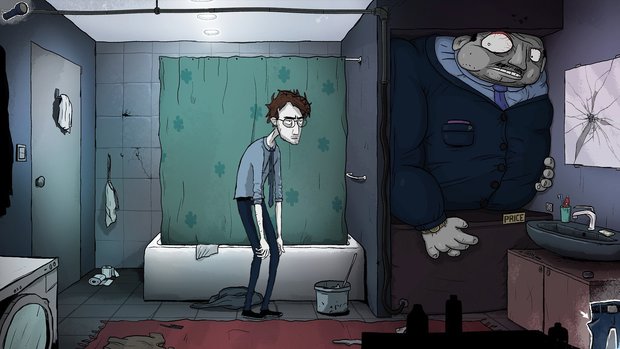
But underneath that sloppy façade is a man with good ideas and loads of humor. Someone who desperately needs to be rid of his cynicism and finally stand up for himself so the world around him can recognize his potential. I wasn’t really expecting it when I started the game, but it didn’t take long for Colin to grow on me and give me the motivation to help him get past the obstacles on his path to a new life.
There’s no better obstacle to start a game at home than the disappearance of a front door! On a seemingly typical day, Colin is going through the weary motions of getting ready for work, ticking off the items on his routine morning task list. Before he can leave, however, he’s surprised to discover that there’s only a bare wall where his gateway to the outside world used to be. Soon even more eerily bizarre things occur, like cryptic messages appearing on his bathroom mirror, as if someone or something is forcing him to take a long, hard look at himself and the life he hates so much.
Colin can’t decide whether he’s losing his mind or having a very vivid nightmare, but something keeps pushing him through new revelations. The apartment he thought he knew so well begins constantly changing its rooms by adding strange items and even stranger characters, some benign and others malevolent, or by transforming the rooms into totally different locations altogether, as if in a different dimension. A recurring shadow that sits on the hallway floor and sinks into it as soon as Colin tries to approach it seems to hold the key to figuring out what exactly is going on. The only thing Colin – and you as the player – can do is to go with this weird flow, engage the obstacles in his path and figure out why all of this is happening to him. The supernatural and surreal elements in this story, sometimes even bordering on light horror, made me think of Silent Hill 4: The Room, but solo developer Rouven Schumacher of Roof Cut Media has turned it into so much more.
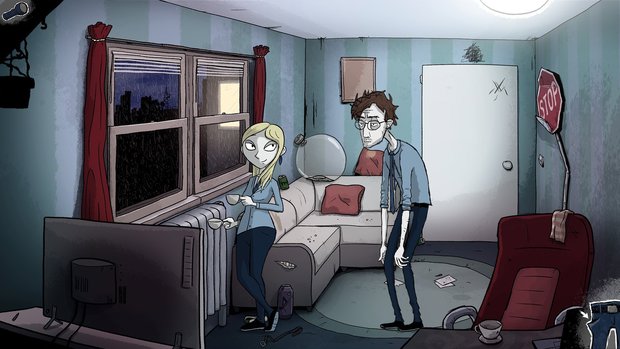
Mindlock has the look and feel of the old Daedalic catalogue. You navigate Colin’s rough and organic hand-drawn 2D apartment with a two-click interface. Left-click lets you examine interactive items, and when indicated by a hand icon next to the magnifying glass icon, you can manipulate them with a right-click as well. The spacebar reveals all hotspots, but you can also click the flashlight icon in the top left corner. Once Colin has dressed for the day, you can click on the pants icon in the bottom right corner to open the inventory, or you can scroll up the mouse wheel. You can combine inventory items with each other or use them directly in the environment, but the inventory will close again once you’ve attempted an interaction, so if you didn’t use an object successfully and want to try it on something else, you have to open up the inventory again.
The apartment consists of the main hallway flanked by four doors leading to the living room, bathroom, bedroom and kitchen. I really loved this intimate setting and how you had to go back and forth between the rooms to solve puzzles. The difficulty of the puzzles was right up my alley, mainly due to this limited setting. I never really had to look very far for possible solutions, although there were a few that had me stuck for a bit, which is how it should be in an adventure game.
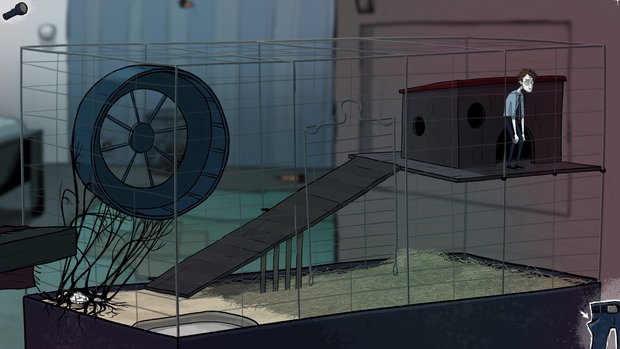
Character movement is very fluid and the backgrounds have small animations as well, like Colin’s pet hamster Sparky running around in his cage in the bedroom, and a distant thunderstorm visible through the living room window and even making the lights flicker in the hallway. But most animations are initiated by the characters, like the tug-of-war game you can play with the shower curtain when a strange old man suddenly appears in the tub. Other than that, the rooms are pretty static.
But while Colin is unable to escape, the gameplay isn’t limited itself to his apartment. Sometimes when Colin wants to devise a plan before taking action, you’ll enter his mind where he sketches out in simple drawings how he must go about achieving his goal. You could regard these as small yet well-integrated mini-games. There’s no dexterity involved, but you will face plenty of repetition as you experiment, which might not be to everyone’s taste.
For instance, before he gets locked in, Colin contemplates how he can drink his coffee on the job without being caught by his boss or interrupted by his customers. Later, after one of many apartment transformations that leaves his living room suddenly looking out at a forest instead of the city, Colin is able to climb out of the window to go exploring, and you will have to devise a way to cross a river by jumping from stone to stone, finding the ideal path without getting stuck. You don’t have an inventory for these sections; you simply have to click on things to try stuff out, and Colin will reply whether the option you have chosen is a good one or not, until you finally progress and he accepts it as a good plan. Thankfully the wrong solutions are usually good for a laugh, except the river puzzle which simply resets once you’ve reached a dead-end.
At other times you have to play through flashback scenes of Colin’s childhood. While still presented in a more simplistic, children’s storybook-esque graphical style than the main game, the drawings aren’t as basic as when Colin is making plans in his head, and they’re a lot more colorful. You also have an inventory in these sections, but the trial and error repetition is still present, such as when you try to sneak past Colin’s dad to go play with a friend.
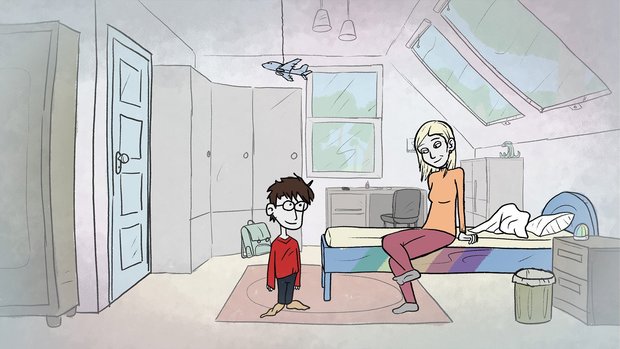
A mechanical puzzle to fix a broken clock was the most time-consuming one (pun intended) for me, involving not just picking the right pieces from a pile and putting them in the correct place, but also in the right order so they don’t block each other. It’s not hard to solve, but I had to keep switching back and forth between the assembly instructions for the clock and the clock itself to repair it; in the end I just took a picture of the manual with my phone for easier reference.
All of these puzzles, as well as another smart one where you have to figure out the code for a keypad, are well integrated into the storyline, feeling like natural obstacles rather than artificial fabrications simply to prolong the gameplay. This integration and the variety of gameplay elements work together to tell Colin’s story in a creatively entertaining way that also manages to feel deeply personal to the protagonist. The game saves automatically every time you make some progress. While it doesn’t do so upon exiting, the lack of manual saves didn’t bother me since I never really had to repeat anything when I restored, except perhaps moving from one room into another.
Mindlock is fully voiced, with Hamish Plaggemars performing the cynical, annoyed, scared, angry and often flabbergasted lead character perfectly – as well as some extra, smaller roles. Colin always has something to say, as everything you look at and every combo you try offers a unique reply. Not once did I hear a repeated line in the “that doesn’t work” vein. Thankfully the writing is as GOOD and funny as it is specifically tailored to your actions. Colin has a dark sense of humor with sarcastic undertones that frequently comes out. For example, when examining the garbage can in his room, he’ll exclaim, “Hey look, my life is in there!” His personality totally fits his graphic design, and it adds a loveable charm to this antihero that quickly makes him more endearing.
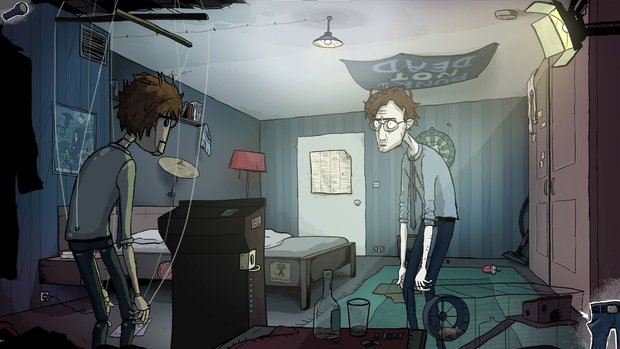
There are lots of funny sight gags to uncover in the game as well. My personal favorite is the music video of the original song “Routines” on Colin’s television, which literally tells the story of his current predicament – with Colin actually part of the video himself. However, the seriousness of its themes becomes apparent pretty early on, when Colin has a panic attack after realizing he’s been locked in and calls the police. There’s a mini-game where you have to calm him down, assisted by the dispatcher’s voice, by following a pattern with your mouse, going up and down as the arrow displays to control his breathing. It’s a short interlude that’s easy enough to do as the player, but certainly not easy for Colin himself to experience, as accentuated by him being depicted as a little kid again for this section.
During his quest to escape, Colin encounters loads of other characters, though some of them are only in his mind. As you meet each, you’ll unlock their profiles in the main menu’s gallery. His parents play a huge role in flashbacks, but the image or memory of his dominant father often shows up in scary ways in the present day, haunting Colin as his once familiar rooms shift into a kind of Wonderland from hell. Colin will also have to bamboozle a handful of co-workers in a surreal version of his office, as well as a nightmarish avatar of his boss, Mr. Price. Others include Screech, the creepy skull-faced owl (don’t ask), in contrast to Snowy, the snowman Colin built as a kid, suddenly come to life. The most surreal “characters” you encounter are the physical manifestations of Colin’s self-doubt and self-confidence, the former with black, fast-moving tentacles obstructing Colin every way possible, the latter a hibernating creature in a flowerbed.
Most disturbing of all, perhaps, is a life-size Colin marionette that moves and talks seemingly on its own, though it’s clear there’s someone tugging on him and preventing him from actually helping Colin. My personal favorite, though, is the enigmatic blonde woman named Veloria, who acts as a subtle guide through Colin’s journey. She’s voiced by the excellent Rhiannon Moushall, whom you might have heard in small roles in games like Old Skies and PRIM. (Seriously, developers, give this woman a lead role already!) At first she just seems to be one more anonymous extra “alternate universe” office worker, but when she suddenly shows up on Colin’s couch, it’s obvious she’s there to provide some stability in his upside-down world. Still, despite her knowing smile, she doesn’t hold Colin’s hand in figuring things out. There’s more to this character than what the game reveals; if she’s not directly in charge of changing Colin’s life, she certainly seems to be the right hand of someone or something who is.
Besides the amazing music video, the rest of Mindlock’s soundtrack shows that developer Rouven Schumacher has plenty of experience working in this field. The themes change for every scene and character you meet, and the score ends up becoming an effective narrative instrument. There are 29 original tracks in total, usually dark and ominous but there are also lighter, more melancholy songs, like in the flashbacks to Colin’s childhood and when Snowy, another memory manifested into being by the supernatural forces currently at play in the apartment, has turned the place into a freezer. (Or perhaps it’s the forces themselves that have done so in order for Snowy to survive there; who knows?) Mainly using violin, cello, guitar and piano, the variation and transition between these styles – from ambient horror to subdued melody – wonderfully match the story’s changing tone: often somber, surreal, but comforting at the right moments.
Final Verdict
Mindlock: The Apartment has everything a classic point-and-click adventure game needs: a lead character you can identify with, great puzzles, amazing music and voice acting, and a realistic setting that’s suddenly turned upside down by an almost magical story filled with strangeness. It’s a dark modern fairy tale with many surprises, both visually and through dialogue, that will creep you out and make you laugh in turn. While it’s only about five hours long, there’s so much content packed in that it doesn’t feel that short. This is a story about believing in yourself and at least trying to reach for the stars instead of giving up and being left only with regret. While Colin felt trapped by his choices, this game succeeded in every way in opening up my own mind, determined to do what I could to help him finally achieve his goals.
Hot take
You’ll be tempted to stay home to finish Mindlock: The Apartment in one go, as it’s a funny-creepy story packed with great gameplay and wrapped up in impressive production values.
Pros
- Great balance between (dark) humor and emotional struggle
- Diverse, creative puzzles integrated nicely into the story
- Excellent voice work with no repetitive dialogue
- Stylish hand-drawn 2D artwork of various styles
Cons
- One puzzle is clunky to solve
- Inventory needs to be reopened each time you (mis)use an item
Johnny played Mindlock: The Apartment on PC using a review code provided by the game’s publisher.


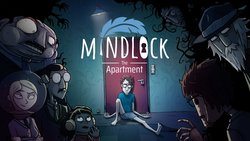
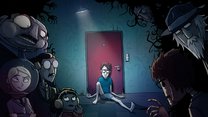



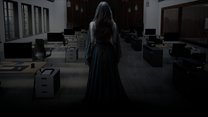

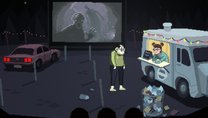

7 Comments
Want to join the discussion? Leave a comment as guest, sign in or register in our forums.
Johnny, you are clearly a very nice guy (based on here and on the Adventure Games Podcast), and you have a lot of knowledge, experience, and love of adventure games. Your reviews should be a go to source for one of the most informed opinions. But they're not. I've realized they're useless, because you are WAY too nice and rate every game way too high. This is not an 88% game. Not even close. A rating that high should be reserved for an all-time classic. Like all of your reviews, you have vastly overrated this fine but really pretty forgettable little game. If you rate every single game like it's the second coming of Grim Fandango or Secret of Monkey Island, it makes your opinion have no value. I click on your reviews at this point just to scroll to the bottom and get a chuckle at seeing whatever latest run of the mill, at best 3/5 stars sort of game you've rated like it belongs in the Adventure Games Hall of Fame.
Reply
Johnny is very passionate and honest. He’s very detailed as to why he believes in the game so I always recommend that you take the reasoning and see if that’s something that you’d like to play. We’re never going to be perfect but you can count on Johnny and the staff to be diligent. We thank you sooooo much for supporting what we do by reading. Please continue with the feedback. We’re always listening. That’s the great thing about adventure games. The community 😊
Reply
Hi Ted, Thanks for diligently reading my reviews! I admit I might not be as critical as others; I do enjoy lots of games, especially when I'm impressed by what people with not that many means can put together. However, I do think I rate fairly, sometimes even asking advice from my editor when I'm in doubt, and when I think a game deserves less I won't hesitate to give a lower score. All-time classics would be in the mid 90s for me, anyway, and I almost give as many games a score in the 90s as in the 60s. My other review scores are almost evenly divided over the 70s and 80s. Here are my numbers, out of 62 reviews: 50s - 3% 60s - 10% 70s - 35% 80s - 39% 90s - 13% Of course my opinion is only mine, one person's opinion (though the other Mindlock review on Metacritic rates it even - albeit only slightly - higher). That's the reason for the long reviews, as Joshua says. Things you enjoy I might not, and clearly vice versa as well. Perhaps there's even a game I gave a low score that you actually like a lot. It's always possible. That's why I try to describe every aspect of a game, so people can make up their own minds. My rating is also based on how the game compares to others, and personal enjoyment, the "funness-factor", and any emotional link I might feel, are a big part of that. The review text should always explain that rather abstract number at the bottom.
Reply
The specs say its available for iOS bit I think it isn’t. It’s not in the App Store for iOS. Could You double check?
Reply
The developers announced a mobile version but it's not out yet. The platforms listed here show all the ones announced, and the "Where to buy" links will show which can be currently purchased.
Reply
@ Ted, I think when you’re criticising a review it’s important that you’ve played the game yourself before immediately focusing on a reviewer’s score. What evidence from your own experience can you provide that Johnny Nys’ reviews are overrating games? I haven’t played every game that Johnny Nys has reviewed but from the reviews of the ones I have read I find them spot on! I know that after Jackal left Adventure gamers that too many games were overrated. I know that they are not here!!! Btw, Grim Fandango had a budget of (allegedly) $ 3,000000. Most games these days are developed on a miniscule of that …but we are still presented with a plethora of interesting games that shouldn’t be criticised on account of less resources!!!
Reply
Thank you, Chrissie!
Reply
Leave a comment